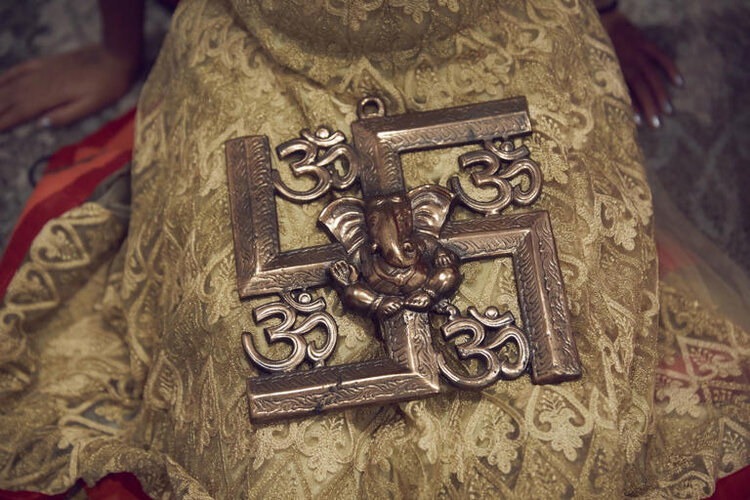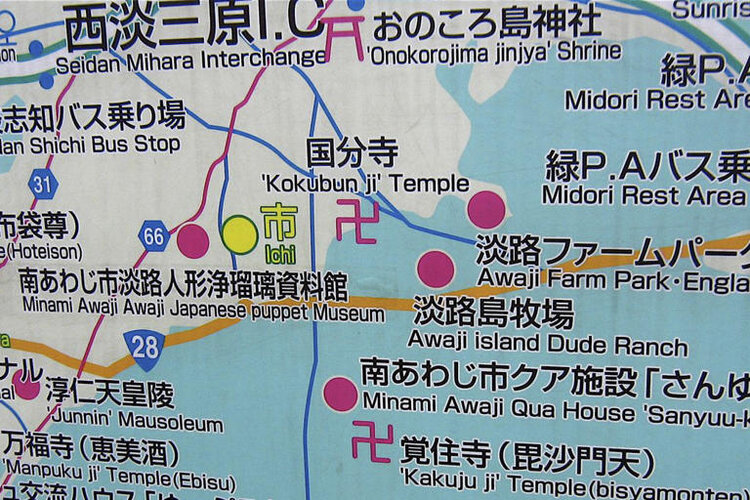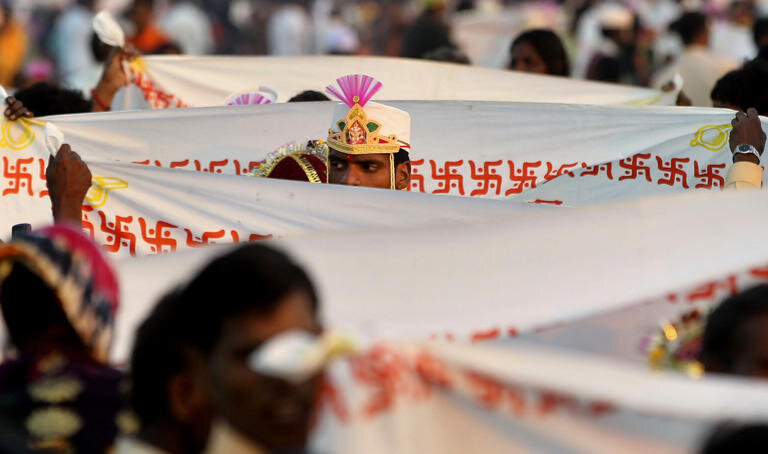- Joined
- Jul 18, 1998
- Messages
- 24,605
- Reaction score
- 52,820
Online
Very interesting article
I've known for a long time that the swastika was an ancient symbol meaning peace, and I feel sorry for people that always considered it a peace symbol that it's been adopted and corrupted into a symbol hate and evil.
But it has, and there's no changing that
===============================
Sheetal Deo was shocked when she got a letter from her Queens apartment building’s co-op board calling her Diwali decoration “offensive” and demanding she take it down.
“My decoration said ‘Happy Diwali’ and had a swastika on it,” said Deo, a physician, who was celebrating the Hindu festival of lights.
The equilateral cross with its legs bent at right angles is a millennia-old sacred symbol in Hinduism, Buddhism and Jainism that represents peace and good fortune, and was also used widely by Indigenous people worldwide in a similar vein.
But in the West, this symbol is often equated to Adolf Hitler’s hakenkreuz or the hooked cross – a symbol of hate that evokes the trauma of the Holocaust and the horrors of Nazi Germany. White supremacists, neo-Nazi groups and vandals have continued to use Hitler’s symbol to stoke fear and hate.
Over the past decade, as the Asian diaspora has grown in North America, the call to reclaim the swastika as a sacred symbol has become louder. These minority faith communities are being joined by Native American elders whose ancestors have long used the symbol as part of healing rituals.
Deo believes she and people of other faiths should not have to sacrifice or apologize for a sacred symbol simply because it is often conflated with its tainted version.
“To me, that’s intolerable,” she said.
Yet to others, the idea that the swastika could be redeemed is unthinkable.
Holocaust survivors in particular could be re-traumatized when they see the symbol, said Shelley Rood Wernick, managing director of the Jewish Federations of North America’s Center on Holocaust Survivor Care.
“One of the hallmarks of trauma is that it shatters a person’s sense of safety,” said Wernick, whose grandparents met at a displaced persons’ camp in Austria after World War II. “The swastika was a representation of the concept that stood for the annihilation of an entire people.”...........
The symbol itself dates back to prehistoric times. The word “swastika” has Sanskrit roots and means “the mark of well being.” It has been used in prayers of the Rig Veda, the oldest of Hindu scriptures. In Buddhism, the symbol is known as “manji” and signifies the Buddha’s footsteps. It is used to mark the location of Buddhist temples.
In China it's called Wàn, and denotes the universe or the manifestation and creativity of God. The swastika is carved into the Jains’ emblem representing the four types of birth an embodied soul might attain until it is eventually liberated from the cycle of birth and death. In the Zoroastrian faith, it represents the four elements – water, fire, air and earth.
In India, the ubiquitous symbol can be seen on thresholds, drawn with vermillion and turmeric, and displayed on shop doors, vehicles, food packaging and at festivals or special occasions. Elsewhere, it has been found in the Roman catacombs, ruins in Greece and Iran, and in Ethiopian and Spanish churches.
The swastika also was a Native American symbol used by many southwestern tribes, particularly the Navajo and Hopi. To the Navajo, it represented a whirling log, a sacred image used in healing rituals and sand paintings. Swastika motifs can be found in items carbon-dated to 15,000 years ago on display at the National Museum of the History of Ukraine as well as on artifacts recovered from the ruins of the ancient Indus Valley civilizations that flourished between 2600 and 1900 BC.
The symbol was revived during the 19th century excavations in the ancient city of Troy by German archaeologist Heinrich Schliemann, who connected it to a shared Aryan culture across Europe and Asia. Historians believe it is this notion that made the symbol appealing to nationalist groups in Germany including the Nazi Party, which adopted it in 1920.
In North America, in the early 20th century, swastikas made their way into ceramic tiles, architectural features, military insignia, team logos, government buildings and marketing campaigns. Coca-Cola issued a swastika pendant. Carlsberg beer bottles came etched with swastikas. The Boy Scouts handed out badges with the symbol until 1940.
The Rev. T.K. Nakagaki said he was shocked when he first heard the swastika referred to as a “universal symbol of evil” at an interfaith conference. The New York-based Buddhist priest, who was ordained in the 750-year-old Jodoshinshu tradition of Japanese Buddhism, says when he hears the word “swastika” or “manji,” he thinks of a Buddhist temple because that is what it represents in Japan where he grew up.
“You cannot call it a symbol of evil or (deny) other facts that have existed for hundreds of years, just because of Hitler," he said.............



I've known for a long time that the swastika was an ancient symbol meaning peace, and I feel sorry for people that always considered it a peace symbol that it's been adopted and corrupted into a symbol hate and evil.
But it has, and there's no changing that
===============================
Sheetal Deo was shocked when she got a letter from her Queens apartment building’s co-op board calling her Diwali decoration “offensive” and demanding she take it down.
“My decoration said ‘Happy Diwali’ and had a swastika on it,” said Deo, a physician, who was celebrating the Hindu festival of lights.
The equilateral cross with its legs bent at right angles is a millennia-old sacred symbol in Hinduism, Buddhism and Jainism that represents peace and good fortune, and was also used widely by Indigenous people worldwide in a similar vein.
But in the West, this symbol is often equated to Adolf Hitler’s hakenkreuz or the hooked cross – a symbol of hate that evokes the trauma of the Holocaust and the horrors of Nazi Germany. White supremacists, neo-Nazi groups and vandals have continued to use Hitler’s symbol to stoke fear and hate.
Over the past decade, as the Asian diaspora has grown in North America, the call to reclaim the swastika as a sacred symbol has become louder. These minority faith communities are being joined by Native American elders whose ancestors have long used the symbol as part of healing rituals.
Deo believes she and people of other faiths should not have to sacrifice or apologize for a sacred symbol simply because it is often conflated with its tainted version.
“To me, that’s intolerable,” she said.
Yet to others, the idea that the swastika could be redeemed is unthinkable.
Holocaust survivors in particular could be re-traumatized when they see the symbol, said Shelley Rood Wernick, managing director of the Jewish Federations of North America’s Center on Holocaust Survivor Care.
“One of the hallmarks of trauma is that it shatters a person’s sense of safety,” said Wernick, whose grandparents met at a displaced persons’ camp in Austria after World War II. “The swastika was a representation of the concept that stood for the annihilation of an entire people.”...........
The symbol itself dates back to prehistoric times. The word “swastika” has Sanskrit roots and means “the mark of well being.” It has been used in prayers of the Rig Veda, the oldest of Hindu scriptures. In Buddhism, the symbol is known as “manji” and signifies the Buddha’s footsteps. It is used to mark the location of Buddhist temples.
In China it's called Wàn, and denotes the universe or the manifestation and creativity of God. The swastika is carved into the Jains’ emblem representing the four types of birth an embodied soul might attain until it is eventually liberated from the cycle of birth and death. In the Zoroastrian faith, it represents the four elements – water, fire, air and earth.
In India, the ubiquitous symbol can be seen on thresholds, drawn with vermillion and turmeric, and displayed on shop doors, vehicles, food packaging and at festivals or special occasions. Elsewhere, it has been found in the Roman catacombs, ruins in Greece and Iran, and in Ethiopian and Spanish churches.
The swastika also was a Native American symbol used by many southwestern tribes, particularly the Navajo and Hopi. To the Navajo, it represented a whirling log, a sacred image used in healing rituals and sand paintings. Swastika motifs can be found in items carbon-dated to 15,000 years ago on display at the National Museum of the History of Ukraine as well as on artifacts recovered from the ruins of the ancient Indus Valley civilizations that flourished between 2600 and 1900 BC.
The symbol was revived during the 19th century excavations in the ancient city of Troy by German archaeologist Heinrich Schliemann, who connected it to a shared Aryan culture across Europe and Asia. Historians believe it is this notion that made the symbol appealing to nationalist groups in Germany including the Nazi Party, which adopted it in 1920.
In North America, in the early 20th century, swastikas made their way into ceramic tiles, architectural features, military insignia, team logos, government buildings and marketing campaigns. Coca-Cola issued a swastika pendant. Carlsberg beer bottles came etched with swastikas. The Boy Scouts handed out badges with the symbol until 1940.
The Rev. T.K. Nakagaki said he was shocked when he first heard the swastika referred to as a “universal symbol of evil” at an interfaith conference. The New York-based Buddhist priest, who was ordained in the 750-year-old Jodoshinshu tradition of Japanese Buddhism, says when he hears the word “swastika” or “manji,” he thinks of a Buddhist temple because that is what it represents in Japan where he grew up.
“You cannot call it a symbol of evil or (deny) other facts that have existed for hundreds of years, just because of Hitler," he said.............







